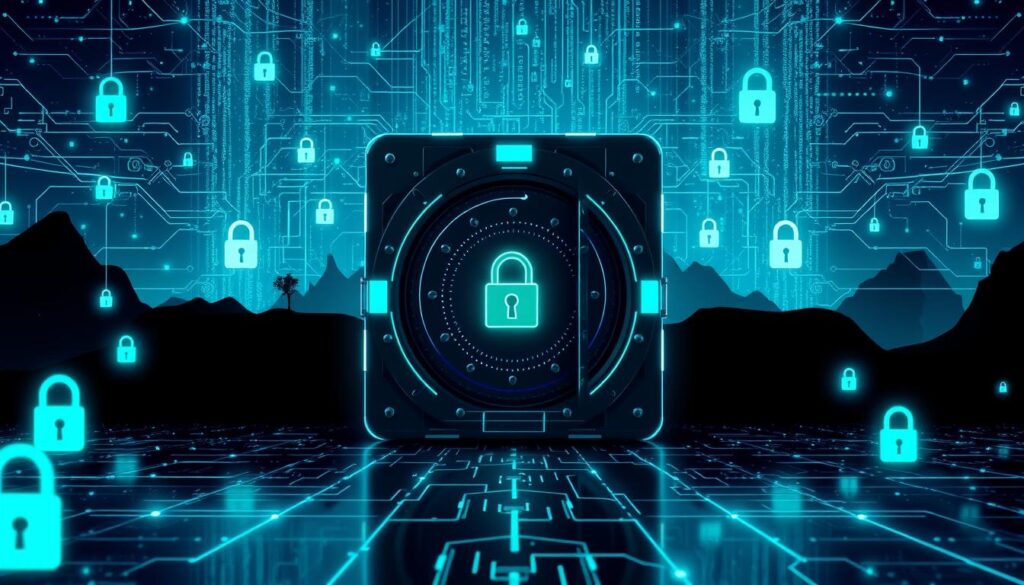The Permiso State of Identity Security Survey Report 2024 gives a detailed look at digital identity management and cybersecurity trends. It dives into the changing world of identity security. It shows key findings, new technologies, and how they affect global cybersecurity.
Permiso, a top identity and access management solutions provider, did this study. It’s an annual report that shares important insights on digital identity protection. It looks at the views and experiences of security experts around the world. The goal is to help organizations deal with identity security challenges in the future.
Key Takeaways
- Comprehensive analysis of the current state of digital identity management and cybersecurity trends
- Exploration of the evolving landscape of identity security, highlighting key findings and emerging technologies
- Insights into the challenges, growth patterns, and best practices surrounding digital identity protection
- Perspectives from security professionals worldwide on the state of identity-centric security
- Guidance for organizations to navigate the complexities of identity-centric security in the future
Executive Summary: Key Findings and Trends
The Permiso State of Identity Security Survey Report 2024 gives us important insights into the changing world of cybersecurity. It shows the big challenges companies face in protecting their digital identities. This summary will cover the main points and trends that will shape the future of identity security.
Major Security Challenges Identified
The report shows that companies are dealing with many security issues. These include:
- More identity-based attacks, like phishing and stolen credentials
- Hard times managing and securing remote workforces
- Challenges in keeping up with data privacy laws and IAM
- Not enough control over third-party access to sensitive data
Statistical Highlights and Growth Patterns
The report gives a detailed look at the current state of identity security. It includes:
- A 45% increase in identity-related data breaches in the last year
- A 28% year-over-year growth in zero trust security adoption
- A 65% implementation rate of multi-factor authentication
- A 20% rise in biometric authentication solutions
Impact on Global Cybersecurity Landscape
The Permiso State of Identity Security Survey Report 2024 highlights the importance of identity security. It shows how identity governance, data privacy, fraud prevention, and zero trust models shape global cybersecurity. The report offers a guide for companies to improve their identity security and stay ahead of new threats.
Understanding Digital Identity Management in 2024
In 2024, digital identity management is changing fast. This is thanks to new tech and the need for identity management, data protection, user authentication, and access control. Companies are now using better ways to keep digital identities safe. This lets users get what they need while keeping sensitive info safe.
Biometric authentication is becoming more popular. This includes fingerprint, facial, and iris scans. It’s a safer and easier way to check who you are, compared to old passwords. This change makes user authentication better and helps protect data protection too.
Access control is also key. Companies are setting strict rules to keep data safe. They use things like multi-factor authentication. This means you need more than one thing to prove who you are, like a password and a code on your phone.
Zero Trust Architecture is also playing a big role. It’s a security model that says everyone and everything is a threat until proven safe. It’s a big help in keeping digital identities safe and stopping unauthorized access.
“The future of digital identity management is all about striking the right balance between security and convenience. Organizations must constantly evolve their strategies to stay ahead of the ever-changing threat landscape.”
The digital world is getting bigger, and so is the need for good identity management, data protection, user authentication, and access control. By using the latest tech and best practices, companies can keep their digital identities safe. This makes the future more secure and connected for everyone.
Evolution of Identity Security Threats and Vulnerabilities
The world of identity security is always changing. This creates big challenges for both companies and people. As technology gets better, hackers find new ways to attack. It’s important to know about these threats and how to protect against them.
Emerging Attack Vectors
New threats like social engineering and credential stuffing are becoming common. Hackers use tricks to get people to share their personal info. They also target digital identities with attacks like account takeover and synthetic identities. This makes strong multi-factor authentication and privacy regulations even more important.
Most Targeted Industry Sectors
- Financial services: Hackers aim for banks and financial companies to get to valuable data and money.
- Healthcare: The healthcare field is a big target because it has lots of personal and medical info.
- Government: Government agencies have a lot of identity security data, making them a big target for hackers.
Common Exploitation Methods
- Phishing and social engineering: Hackers trick people into giving up their login details or other sensitive info.
- Credential stuffing: Hackers use stolen login info to get into accounts they shouldn’t have access to.
- Brute-force attacks: Hackers try lots of password combinations to get past identity security checks.
As the digital world keeps changing, companies need to be ready. They must have strong risk assessment and identity security plans to fight off identity attacks.
“The cybersecurity world is always moving, and identity threats are at the center of it. To stay ahead, you need to understand new threats and be proactive in identity security risk management.”
Permiso State of Identity Security Survey Report 2024: Methodology and Scope
The Permiso State of Identity Security Survey Report 2024 dives deep into data privacy, regulatory compliance, risk management, and authentication protocols. It uses a detailed approach to understand the latest challenges and trends in identity security.
The team used both quantitative and qualitative methods to collect data. They conducted online surveys, in-depth interviews, and secondary research. This way, they reached a wide range of professionals across different industries.
| Survey Respondents by Industry | Percentage |
|---|---|
| Technology and IT | 35% |
| Financial Services | 22% |
| Healthcare | 15% |
| Retail and e-Commerce | 12% |
| Other Sectors | 16% |
The report covers many topics, like identity security threats, zero-trust architectures, and biometric authentication. It also looks at how regulatory compliance affects data privacy. The goal is to offer insights and strategies for dealing with identity security challenges.

“The findings from this survey serve as a valuable resource for businesses and policymakers to understand the current state of identity security and make informed decisions to protect their organizations and customers.”
Zero Trust Architecture Implementation and Success Rates
Organizations are now focusing on zero trust architecture to boost their cybersecurity. This new method doesn’t rely on a single security point. Instead, it checks user identity, device health, and session context for every access request.
Benefits of Zero Trust Adoption
Adopting zero trust architecture brings many benefits. These include:
- Improved access control measures that lower the risk of unauthorized access
- Enhanced data security through biometric identification and advanced access management techniques
- Increased visibility and control over user activities and network traffic
- Reduced attack surface and mitigation of breach impacts
Implementation Challenges and Solutions
While zero trust architecture offers great benefits, challenges arise. These include:
- Complexity in integrating zero trust with legacy systems
- Resistance to new security protocols from users
- Lack of skilled staff to design and deploy zero trust solutions
To tackle these challenges, organizations should:
- Create a detailed zero trust roadmap and plan
- Invest in training for IT and security teams
- Adopt zero trust in phases, starting with critical assets
Best Practices and Recommendations
For successful zero trust architecture implementation, follow these best practices:
- Set up a centralized identity and access management system
- Use continuous monitoring and adaptive access controls
- Regularly update zero trust policies to keep up with threats
- Work with industry experts and peers to learn from their experiences
By embracing zero trust architecture and following these best practices, organizations can strengthen their cybersecurity. They can better protect their critical assets from new threats.
Biometric Authentication: Adoption Rates and Effectiveness
The use of biometric authentication is growing fast in digital identity management. This tech uses unique traits like fingerprints and facial features to make access safer and easier. It’s all about improving security and making it simpler to get to important systems and data.
The Permiso State of Identity Security Survey Report 2024 shows more industries are using biometric authentication. It finds that companies are moving away from old password systems. They see passwordless authentication as better for users and more secure.
But, there are hurdles to using biometric authentication. The report talks about compliance regulations and keeping user data safe. It also points out that making sure biometric authentication works well against threats is still a work in progress.
| Industry Sector | Biometric Authentication Adoption Rate |
|---|---|
| Financial Services | 78% |
| Healthcare | 65% |
| Government | 71% |
| Technology | 82% |
As we move forward in digital identity management, the Permiso Survey Report 2024 is very helpful. It gives advice on how to use biometric authentication to boost security. It also helps meet industry rules.

“Biometric authentication is a game-changer in the fight against cybercrime, offering a seamless and secure way for users to access critical systems and data.”
Regulatory Compliance and Data Privacy Standards
In today’s digital world, keeping up with data privacy rules is key for companies everywhere. As these rules change, businesses face a tough task. They must follow strict standards to avoid big fines or legal trouble.
Global Privacy Regulations Impact
The EU’s GDPR and California’s CCPA have changed how companies handle personal data. These laws push for better data protection. They demand strong security measures to fight insider threats and unauthorized access.
Compliance Challenges and Solutions
Keeping up with data privacy laws can be hard for companies. They face:
- Dealing with fast-changing data privacy laws
- Ensuring they follow all data privacy regulations and regulatory compliance rules
- Stopping insider threats and weak spots in their systems
- Using a zero trust architecture to boost data safety
To tackle these issues, companies need to be proactive. They should stay updated on new laws, do regular risk checks, and use strong security tools. A solid, multi-layered security plan helps them stay ahead in the changing compliance world and protect their customers’ data.
| Regulation | Key Requirements | Potential Penalties |
|---|---|---|
| GDPR |
|
Up to 4% of global annual revenue or €20 million, whichever is higher |
| CCPA |
|
Up to $7,500 per violation |
“Keeping up with data privacy and security is now a must for businesses. Those who ignore these rules face big financial and reputation losses.”
Multi-Factor Authentication Trends and Implementation
In today’s world, cybersecurity threats are changing fast. Multi-factor authentication (MFA) is now key in fighting fraud. It’s a detailed way to check who gets access to important data and systems.
More and more companies are using MFA to protect their data. They choose from SMS codes, mobile apps, biometrics, and hardware tokens. Each has its own benefits and things to think about when setting it up.
| MFA Method | Adoption Rate | Perceived Effectiveness | Key Considerations |
|---|---|---|---|
| SMS-based OTP | 65% | Moderate | Vulnerability to SIM swapping attacks |
| Mobile App Authenticators | 75% | High | Requires smartphone ownership and mobile app integration |
| Biometric Verification | 45% | Very High | Concerns around data privacy and false acceptance rates |
| Hardware Security Tokens | 30% | Very High | Additional cost and physical device management |
Even though MFA is getting more popular, setting it up can be tough. Companies struggle with getting users to accept it, fitting it into their systems, and managing it. But, MFA’s benefits in making user authentication, access control, and fraud prevention strategies better are pushing its use in many fields.
“Multi-factor authentication is no longer a luxury, but a necessity in today’s cybersecurity landscape. It’s a critical line of defense against the growing threat of identity-based attacks.”
Risk Management Strategies and Identity Governance
Organizations are working hard to protect their digital assets. They need strong risk management and identity governance plans. These help them deal with the changing world of access management and privileged access.
Risk Assessment Frameworks
A good risk assessment is key to a strong security plan. Companies must use detailed frameworks to spot and handle threats to their digital identities. This includes:
- Keeping an eye on who has access to what
- Updating access rules often
- Managing identities from start to finish
- Following rules set by industries
Identity Lifecycle Management
Good identity governance means managing digital identities from start to end. This means:
- Setting up new user identities
- Checking and updating existing identities
- Removing accounts when they’re no longer needed
- Handling user credentials safely
By using these methods, companies can better manage risks. They can also reduce threats to their identities and keep their identity governance strong.
Future Outlook: Emerging Technologies and Predictions
The digital world is changing fast, and so is the field of cybersecurity. Experts think we’ll see big changes in how we handle cybersecurity trends, biometric authentication, and passwordless authentication.
One big change is the use of zero trust security models. This new way of thinking about security will make our data safer. It will focus on checking who and what is accessing our digital stuff, all the time.
Artificial intelligence (AI) and machine learning (ML) will also change how we fight cyber threats. These technologies will help us analyze security data quickly. This means we can spot and fix problems before they become big issues.
Quantum computing is another big topic. It could make our data safer, but it could also make old security methods useless. Experts are working on new ways to keep our digital world safe from quantum threats.
Looking ahead, we’ll see more use of biometric authentication and passwordless authentication. These methods aim to make things easier for users while keeping our data safe. They get rid of the need for passwords, which are often a weak point for hackers.
The future of cybersecurity will be shaped by new technologies and our dedication to keeping our digital world safe.
Conclusion
The Permiso State of Identity Security Survey Report 2024 has given us a clear view of digital identity management. It shows that protecting data and assets is a big challenge. A proactive approach to identity security is key.
The report talks about the growing threats of identity theft. It also points out the need for strong identity governance. Businesses need to use zero-trust architectures, biometric authentication, and multi-factor authentication to keep their digital identities safe.
The report also looks at the future, highlighting how new technologies like artificial intelligence and blockchain can help. By keeping up with these advancements, companies can protect their digital identities better.
FAQ
What are the major security challenges identified in the Permiso State of Identity Security Survey Report 2024?
The report points out several big security issues. These include advanced identity theft methods, insider threats, and managing digital identities in complex environments.
What are the key statistical highlights and growth patterns presented in the report?
The report shows an increase in identity security breaches. It also talks about the rise in biometric authentication and big investments in identity solutions.
How does the Permiso State of Identity Security Survey Report 2024 address the impact on the global cybersecurity landscape?
The report looks at how identity security is changing the cybersecurity world. It focuses on zero trust models, passwordless authentication, and stronger data privacy laws.
What are the emerging attack vectors and most targeted industry sectors highlighted in the report?
The report talks about new attack methods like social engineering and supply chain attacks. It also says healthcare, finance, and government are often targeted.
How does the report explain the methodology and scope of the Permiso State of Identity Security Survey?
The report explains how the survey was done. It covers the data collection, sample size, and who was surveyed. This ensures the findings are clear and accurate.
What are the key benefits and challenges associated with the implementation of Zero Trust Architecture?
The report discusses Zero Trust’s benefits, like better access control and less attack surface. It also talks about the challenges, like fitting it with old systems and changing company culture.
What is the current state of biometric authentication adoption and effectiveness in enhancing security?
The report looks at how biometric tech, like facial recognition, is being used more. It checks if it makes security better and talks about privacy and law issues.
How does the report address the impact of global data privacy regulations on identity security?
The report talks about how big privacy laws, like GDPR and CCPA, affect identity security. It looks at the challenges and how companies follow these laws.
What are the current trends and best practices in multi-factor authentication implementation?
The report covers the latest in multi-factor authentication, like biometric and mobile MFA. It gives tips on how to use MFA well to prevent fraud.
How does the report address identity governance and risk management strategies?
The report highlights the need for strong identity governance. It talks about managing risk, identity lifecycle, and using access controls to fight insider threats.
What are the key predictions and emerging technologies highlighted in the report’s future outlook?
The report looks at new tech like advanced biometrics and passwordless systems. It talks about how these might change identity security and cybersecurity in the future.

